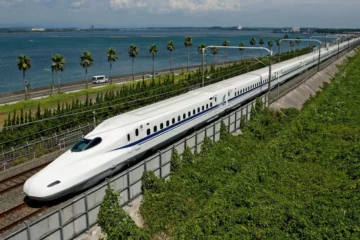From Steam Engines to High-Speed Rails: Exploring the Evolution of Trains

Steam Engines to High-Speed Rails | bebevy
Trains have been a staple of transportation for over two centuries, revolutionizing the way people and goods move across vast distances. From the early steam engines of the 1800s to the high-speed rails of today, trains have undergone a remarkable evolution. They have not only played a significant role in shaping the course of history but also continue to shape our modern world. The technological advancements in train engineering have made it possible to travel faster, safer, and more efficiently than ever before.
In this article, we will explore the fascinating journey of trains, from their humble beginnings to the modern-day marvels of engineering. Join us as we take a trip down memory lane and uncover the milestones that have shaped the evolution of trains.
The Steam Engine Era
The steam engine is the foundation of the modern railway system and is the earliest form of train power. In the early 1800s, steam engines were used to power trains in England, where the first public railway was established. The steam engine was a revolutionary invention that allowed trains to travel faster and farther than ever before. It consisted of a boiler, which heated water to produce steam, and a cylinder, which converted the steam into motion.
One of the most famous steam engines was the Rocket, built by George Stephenson in 1829. The Rocket was the first steam engine to reach a speed of 30 miles per hour, and it was used to haul passengers and goods on the Liverpool and Manchester Railway. The steam engine era lasted for over a century, and during this time, trains became the primary mode of transportation for both people and goods.
However, steam engines had their drawbacks. They were noisy, produced a lot of smoke and pollution, and required a lot of maintenance. As a result, the development of diesel-electric locomotives marked the end of the steam engine era.
The Development of Diesel-Electric Locomotives
The first diesel-electric locomotive was built in 1918 by General Electric, but it wasn’t until the 1930s that they started to become widely used. Diesel-electric locomotives were faster, more efficient, and required less maintenance than steam engines. They used a diesel engine to generate electricity, which powered an electric motor that drove the wheels.
The diesel-electric locomotive was a game-changer for the railway industry. It allowed trains to travel faster and more efficiently, and it made it possible to haul longer and heavier trains. As a result, trains became an even more important mode of transportation for both people and goods.
The Era of High-Speed Rails
The 1960s marked the beginning of the era of high-speed rails. Japan was the first country to develop a high-speed rail system, known as the Shinkansen, which began operating in 1964. The Shinkansen was designed to travel at speeds of up to 200 miles per hour, and it revolutionized train travel.
Other countries soon followed suit, and high-speed rail systems were developed in Europe, China, and other parts of the world. High-speed rails are designed to travel at speeds of over 150 miles per hour, and they offer a comfortable and efficient mode of transportation for both passengers and goods.
Maglev Trains and Their Technology
Maglev trains are the latest innovation in train technology. They use magnetic levitation to propel trains along the tracks, eliminating the need for wheels and allowing trains to travel at even higher speeds. Maglev trains are currently in operation in several countries, including Japan, China, and South Korea.
Maglev trains work by using powerful magnets to lift the train off the tracks and propel it forward. This technology allows trains to travel at speeds of up to 375 miles per hour, making them the fastest trains in the world. Maglev trains are also very quiet, efficient, and environmentally friendly, making them an attractive alternative to traditional trains.
The Impact of Trains on Transportation and Society
Trains have had a significant impact on transportation and society. They have made it possible to travel quickly and efficiently across long distances, and they have facilitated the movement of goods and people across the world. Trains have also played a significant role in the development of cities and the growth of economies.
The railway industry has created numerous jobs and has contributed to the growth of many industries, including manufacturing, agriculture, and tourism. Trains have also had a significant impact on the environment, both positive and negative. While trains are more energy-efficient than cars or planes, they also produce a significant amount of pollution and contribute to global warming.
Famous Trains and Railway Journeys Around the World
Trains have been the subject of many famous books, movies, and songs. Some of the most famous trains in history include the Orient Express, the Trans-Siberian Railway, and the California Zephyr. These trains have inspired countless writers, artists, and travelers, and they continue to capture the imagination of people around the world.
Railway journeys are also a popular form of travel for people who want to experience the beauty of the world from a different perspective. From the Rocky Mountaineer in Canada to the Glacier Express in Switzerland, there are many stunning railway journeys that offer breathtaking views and unforgettable experiences.
Preservation and Restoration of Historic Trains and Railways
Preservation and restoration of historic trains and railways are important for preserving the history and heritage of the railway industry. Many historic trains and railways have been preserved and restored to their former glory, and they offer a glimpse into the past and the evolution of trains.
The National Railway Museum in York, England, is home to a vast collection of historic trains and artifacts, including the Rocket and the Flying Scotsman. Other museums and organizations around the world also work to preserve and restore historic trains and railways, ensuring that future generations can learn about the history of trains.
Future of Trains: Hyperloop and Other Innovations
The future of trains is exciting and full of possibilities. One of the most promising innovations is the Hyperloop, a high-speed transportation system that uses vacuum-sealed tubes to transport passengers and goods at speeds of up to 700 miles per hour. The Hyperloop has the potential to revolutionize transportation and could make it possible to travel between cities in just a few minutes.
Other innovations in train technology include the use of artificial intelligence, robotics, and renewable energy sources. These innovations could help to make trains even faster, safer, and more efficient, and could further reduce the environmental impact of trains.
Conclusion: Trains and Their Enduring Legacy in Modern Society
Trains have come a long way since the early steam engines of the 1800s. They have undergone a remarkable evolution, from the diesel-electric locomotives of the mid-20th century to the high-speed rails and maglev trains of today. Trains have played a significant role in shaping the course of history and continue to shape our modern world.
Trains have had a significant impact on transportation, society, and the environment. They have created jobs, facilitated the movement of goods and people, and contributed to the growth of economies. Trains have also inspired countless writers, artists, and travelers, and they continue to capture the imagination of people around the world.
The future of trains is exciting and full of possibilities. From the Hyperloop to other innovations in train technology, the potential for trains to revolutionize transportation is immense. Trains have an enduring legacy in modern society, and they will continue to shape the way we live, work, and travel for many years to come.








